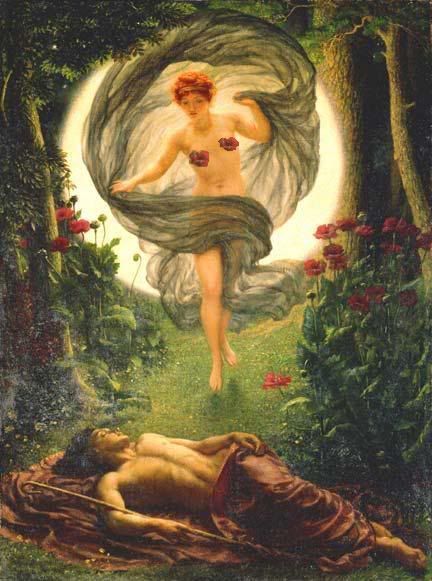Post by bluefedish on Jul 16, 2007 21:55:09 GMT -5
In Greek mythology, Selene was an archaic lunar deity and the daughter of the titans Hyperion and Theia. In Roman mythology the moon goddess is called Luna, latin for "moon".
Like most moon deities, Selene plays a fairly large role in her pantheon. However, Selene was eventually largely supplanted by Artemis, and Luna by Diana. In the collection known as the Homeric hymns, there is a Hymn to Selene, paired with the hymn to Helios; in it Selene is addressed as "far-winged", an epithet ordinarily applied to birds.
The etymology of Selene is uncertain, but if the word is of Greek origin, it is likely connected to the word selas, meaning "light". Boreion Selas is the Greek name for Aurora Borealis. The name is the root of selenology, the study of the geology of the Moon. The chemical element selenium was also named after Selene. Selina is also now an uncommon girls name.
Depictions
In post-Renaissance art, Selene is generally depicted as a beautiful woman with a pale face, riding a silver chariot pulled by a yoke of oxen or a pair of horses. Often, she has been shown riding a horse or bull, wearing robes and a half-moon on her head and carrying a torch. Essentially, Selene is the moon goddess but is literally defined as 'the moon'.
Myths
Genealogy:
In the traditional pre-Olympian divine genealogy, Helios, the sun, is Selene's brother: after her brother, Helios, finishes his journey across the sky, Selene, freshly washed in the waters of Earth-circling Ocean,[3] begins her own journey as night falls upon the earth, which becomes lit from the radiance of her immortal head and golden crown[4]. When she is increasing after mid-month, it is a "sure token and a sign to mortal men". Her sister, Eos, is goddess of the dawn. Eos also carried off a human lover, Cephalus,[5] which mirrors a myth of Selene and Endymion.
As a result of Selene being conflated with Artemis, later writers sometimes referred to Selene as a daughter of Zeus, like Artemis, or of Pallas the Titan. In the Homeric Hymn to Hermes, with its characteristically insistent patrilineality, she is "bright Selene, daughter of the lord Pallas, Megamedes' son."

Selected Source:
en.wikipedia.org/wiki/Selene
Like most moon deities, Selene plays a fairly large role in her pantheon. However, Selene was eventually largely supplanted by Artemis, and Luna by Diana. In the collection known as the Homeric hymns, there is a Hymn to Selene, paired with the hymn to Helios; in it Selene is addressed as "far-winged", an epithet ordinarily applied to birds.
The etymology of Selene is uncertain, but if the word is of Greek origin, it is likely connected to the word selas, meaning "light". Boreion Selas is the Greek name for Aurora Borealis. The name is the root of selenology, the study of the geology of the Moon. The chemical element selenium was also named after Selene. Selina is also now an uncommon girls name.
Depictions
In post-Renaissance art, Selene is generally depicted as a beautiful woman with a pale face, riding a silver chariot pulled by a yoke of oxen or a pair of horses. Often, she has been shown riding a horse or bull, wearing robes and a half-moon on her head and carrying a torch. Essentially, Selene is the moon goddess but is literally defined as 'the moon'.
Myths
Genealogy:
In the traditional pre-Olympian divine genealogy, Helios, the sun, is Selene's brother: after her brother, Helios, finishes his journey across the sky, Selene, freshly washed in the waters of Earth-circling Ocean,[3] begins her own journey as night falls upon the earth, which becomes lit from the radiance of her immortal head and golden crown[4]. When she is increasing after mid-month, it is a "sure token and a sign to mortal men". Her sister, Eos, is goddess of the dawn. Eos also carried off a human lover, Cephalus,[5] which mirrors a myth of Selene and Endymion.
As a result of Selene being conflated with Artemis, later writers sometimes referred to Selene as a daughter of Zeus, like Artemis, or of Pallas the Titan. In the Homeric Hymn to Hermes, with its characteristically insistent patrilineality, she is "bright Selene, daughter of the lord Pallas, Megamedes' son."

Selected Source:
en.wikipedia.org/wiki/Selene



